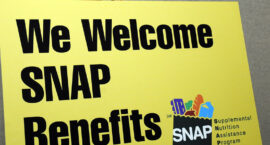In one of its last sessions of 2021, Congress passed a pared-down version of the Military Family Basic Needs Allowance as part of the Fiscal Year 2022 National Defense Authorization Act (NDAA). This marks an important first step toward closing gaps in our social safety net through which currently-serving military families have been allowed to fall. But it’s miles from enough.
In the wake of Congress’s lackluster response, it is more urgent than ever for the administration to use its authority to take action on concrete, long-term solutions to address military hunger.






